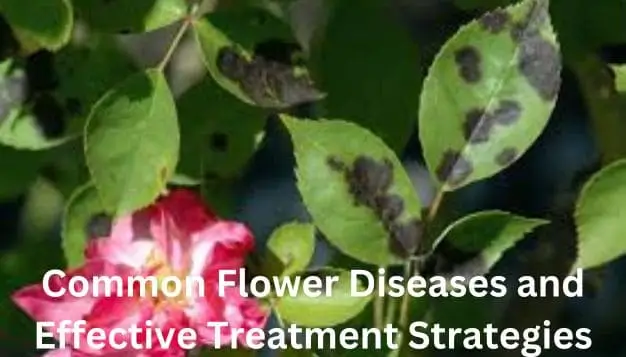Flowers are not only a feast for the eyes but also a source of joy for gardening enthusiasts. However, just like any other plants, flowers are susceptible to diseases that can affect their growth and overall health. Recognizing common flower diseases and understanding how to treat them is crucial for maintaining a vibrant and thriving garden.
Even the most attentive gardeners may find their flowers afflicted by fungal, bacterial or viral plant diseases. Catching these diseases early and taking appropriate action is key to saving your flowers.
In this comprehensive guide, we will explore some prevalent flower diseases and discuss effective treatment methods to keep your garden in full bloom.
Powdery Mildew
One of the most common flower diseases, powdery mildew appears as a white, powdery substance on the leaves, stems, and flowers. This fungal infection thrives in warm, dry conditions.
Signs of powdery mildew include distorted plant growth, spots on leaves and buds, browning flowers and a white powdery coating. The disease eventually causes flowers and buds to wither and die. Powdery mildew can spread rapidly to surrounding plants through wind and water.
To treat, use neem oil or a sulfur-based fungicide according to label instructions and apply fungicides specifically designed for powdery mildew. Improve air circulation around plants by thinning crowded areas and removing weeds. Water at the base of plants in the morning to avoid wet leaves at night.
Botrytis Blight (Gray Mold)
Botrytis blight is a fungal disease that causes grayish mold on flowers, It is most prevalent in cool, damp weather and often strikes mature or aging flowers and buds. Proper spacing of plants, ensuring good air circulation, and removing affected flowers promptly can help control the spread. Fungicides can be applied preventatively or as a treatment measure, but proper sanitation practices remain crucial.
Prune and remove infected plant material promptly. Water in the morning instead of at night. Apply appropriate fungicide sprays as a preventative measure when conditions favor the disease. Remove any dead leaves or debris around plants that may harbor spores.
Downy Mildew
Downy mildew is a fungal infection that manifests as yellow spots on the upper side of leaves and a downy, purplish growth on the undersides. Adequate spacing, watering at the base of plants, and applying copper-based fungicides are effective ways to manage downy mildew. Remove and dispose of infected plant material to prevent further spread.
Rust
Rust is a common fungal disease that appears as orange or rusty-colored spots on leaves. This disease thrives in damp conditions. To treat rust, remove and destroy infected leaves, provide proper spacing, and ensure plants are well-ventilated. Fungicides containing neem oil or sulfur can be effective in preventing and treating rust.
Bacterial Leaf Spot
Bacterial leaf spot causes dark, water-soaked lesions on leaves, eventually leading to yellowing and wilting. To manage bacterial leaf spot, practice proper watering techniques (avoid overhead watering), remove affected leaves, and apply copper-based bactericides. Additionally, improve air circulation to reduce humidity around plants.
Aphids
While not a disease, aphids are common pests that can significantly impact flower health. These tiny, sap-sucking insects can cause distorted growth and transmit diseases. Control aphids by using insecticidal soap, neem oil, or introducing natural predators like ladybugs. Regularly inspect plants for early detection and intervention.
Spider Mites
Spider mites are microscopic pests that suck plant juices, causing stippling and discoloration. Increase humidity, regularly hose down plants, and use miticides to control spider mite infestations. Encouraging beneficial predators like predatory mites can also contribute to effective control.
Root Rot
Root rot is a soil-borne disease caused by various fungi, resulting in a decline in plant health and wilting. To prevent and treat root rot, ensure well-draining soil, avoid overwatering, and use fungicides if necessary. Consider applying beneficial nematodes to the soil to control fungal populations.
Verticillium Wilt
This soil-borne fungal disease infects through the roots and blocks the plant’s vascular system. It causes foliage to wilt, yellow and drop. Affected stems and roots turn brown or black. It persists in soil and spreads via water, tools and roots.
Verticillium wilt is difficult to combat once plants are infected. Solarize soil prior to planting to kill fungi. Rotate flower locations each year and do not compost infected material. Remove and destroy diseased plants promptly to prevent spreading. Fungicide drenches can help protect healthy plants.
Mosaic Virus
Mosaic virus causes a distinctive mottling, curling, yellowing and distortion of leaves and flowers. It spreads easily through pruning tools, infected seeds and soil, and insects like aphids and leafhoppers. The virus can quickly infect entire beds of flowers.
Promptly remove and destroy infected plants to prevent virus spread. Disinfect tools after use on infected plants. Control insect spreaders like aphids and leafhoppers. Do not compost diseased debris. Protect new plantings with insect barriers and row covers. There is no cure once plants are infected.
Conclusion
Maintaining a healthy and vibrant flower garden requires diligence and proactive measures to identify and treat common diseases. Regular inspection, proper sanitation practices, and timely intervention are key to preventing the spread of infections.
By understanding the characteristics of various flower diseases and implementing effective treatment strategies, gardeners can enjoy a flourishing display of colors and fragrances in their gardens throughout the growing season. Remember, a healthy Gardener always Avoid Common Flower Care Mistakes.

